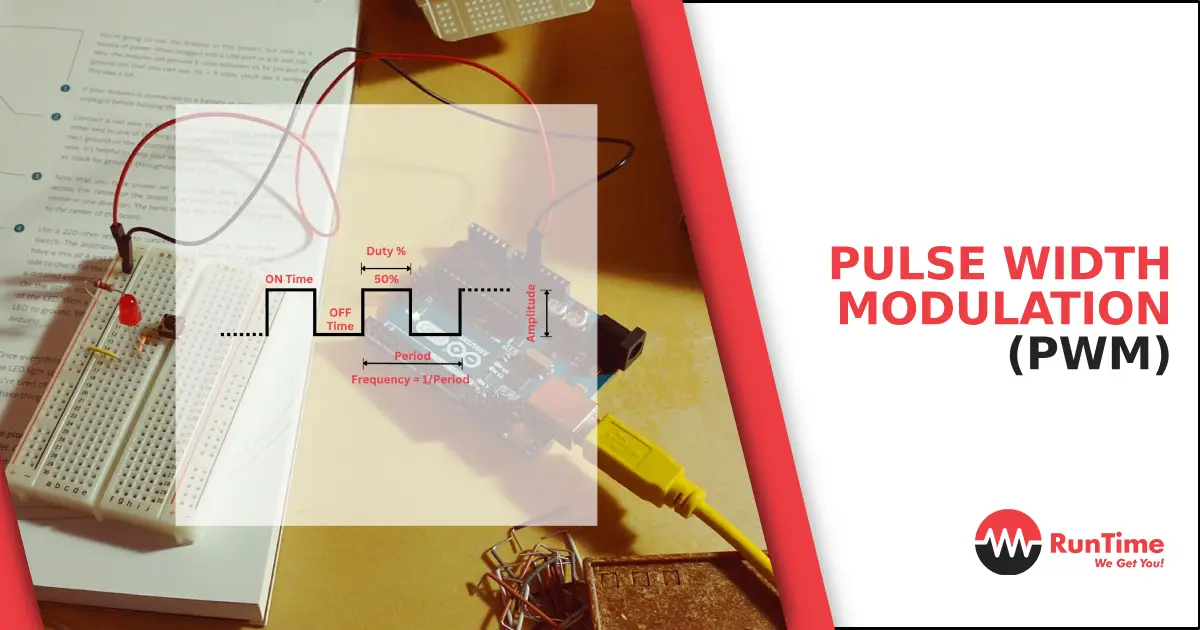Learning and mastering Pulse Width Modulation (PWM) is a crucial skill that empowers you to control the intensity of various devices and components, from LEDs to motors and beyond. In this comprehensive guide, we’ll delve into the intricacies of PWM, equipping you with the knowledge and skills needed to not just understand, but also implement PWM effectively in your electronic projects.
What is Pulse Width Modulation (PWM)?
Pulse Width Modulation (PWM) is a technique used to control the average voltage supplied to a device or component by adjusting the width of a series of pulses. It works by rapidly turning a signal on and off at a specific frequency. The crucial element of PWM is the duty cycle, which represents the percentage of time the signal is “on” (high voltage) compared to the total time of one cycle.
How does Pulse Width Modulation Work?
- Signal Generation: To start, a PWM signal is generated by a microcontroller or PWM module. This signal consists of a series of square wave pulses.
- Duty Cycle: The duty cycle is determined by the ratio of the time the signal is high (on) compared to the time it’s low (off). For example, a 50% duty cycle means the signal is high for half the time and low for the other half.
- Frequency: The PWM signal is generated at a specific frequency, which is the rate at which the signal repeats. Common frequencies in electronics are in the kilohertz or megahertz range.
- Controlling Power or Intensity: By adjusting the duty cycle, you can control the average voltage supplied to the load. A higher duty cycle means the load receives more power or voltage, while a lower duty cycle results in less power or voltage.
For example, let’s say you are using PWM to control the brightness of an LED. If the duty cycle is 50%, the LED will appear to shine at half its maximum brightness because it’s receiving power for only half of each cycle. If you increase the duty cycle to 75%, the LED will shine brighter because it’s on for a more significant portion of the cycle.
PWM in the Real World
1. PWM for LED Brightness Control
PWM is the go-to method for controlling the brightness of LEDs in various applications. By adjusting the duty cycle, you can make LEDs shine at different intensities, a technique commonly found in displays, backlighting, and indicator lights.
2. PWM for Motor Speed Control
In robotics and automation, PWM plays a pivotal role in controlling motor speed. By changing the duty cycle, you can precisely control the rotation speed of motors, leading to smoother movements and enhanced precision in your projects.
Other PWM Applications
Pulse Width Modulation (PWM) technology finds diverse applications beyond the basics. Some other noteworthy applications include:
- Buzzer Loudness Control: PWM can be employed to vary the loudness of a buzzer, allowing for customized sound output, such as in alarm systems or musical devices.
- Servo Direction Control: Servo motors can be steered in specific directions by employing PWM signals, enabling precision in tasks like robotics and remote control systems.
- Analog Output Generation: PWM signals can be filtered to create an analog-like voltage level, useful in applications where continuous voltage control is required.
- Audio Signal Generation: PWM can be harnessed to create audio signals, making it useful in applications such as tone generation and audio playback.
- Telecommunication Message Encoding: In the realm of telecommunications, PWM is employed for encoding messages, and enhancing data transmission and reception in modern communication systems.
These diverse applications highlight the versatility and importance of PWM technology across various industries and domains.
Implementing Pulse Width Modulation (PWM)
The Components You’ll Need
Before diving into PWM, ensure you have the following components ready:
- Microcontroller: You’ll need a microcontroller that supports PWM, such as an Arduino or Raspberry Pi.
- Load Device: This can be an LED, motor, or any component you wish to control.
- Power Supply: Make sure you have a stable power source to avoid voltage fluctuations.
The PWM Configuration
Configuring PWM on your microcontroller involves selecting the appropriate pins and specifying the desired frequency and duty cycle. The exact steps may vary based on your microcontroller model, so be sure to refer to your device’s documentation for precise instructions.
Fine-Tuning Your Pulse Width Modulation (PWM) Skills
Mastering PWM takes practice and experimentation. Here are a few tips to help you refine your skills:
1. Start Simple
Begin with basic projects like LED brightness control and progress to more complex applications as you gain confidence.
2. Oscilloscope for Precision
Invest in an oscilloscope to visualize your PWM signals and fine-tune your duty cycle for optimal results.
3. Explore Advanced Features
Many microcontrollers offer advanced PWM features, such as phase-correct PWM and frequency adjustment. Delve into these features to unlock new possibilities.
Conclusion
Pulse Width Modulation (PWM) is a versatile tool in the world of electronics. Whether you’re illuminating an LED, controlling a motor, or implementing more advanced applications, mastering PWM is a skill that will set you apart in the world of electronics. So, roll up your sleeves, gather your components, and start experimenting with PWM today to bring your projects to life with precision and finesse.
Hire the Best Engineers with RunTime Recruitment
Our expert team of engineers-turned-recruiters offers in-depth knowledge of technical recruiting in the engineering industry.
If your company is looking to recruit highly skilled engineers worldwide, contact us today and we will do the sourcing for you. Or if you’re an engineer looking for new opportunities, you can check RunTime Recruitment’s job site for job vacancies.









